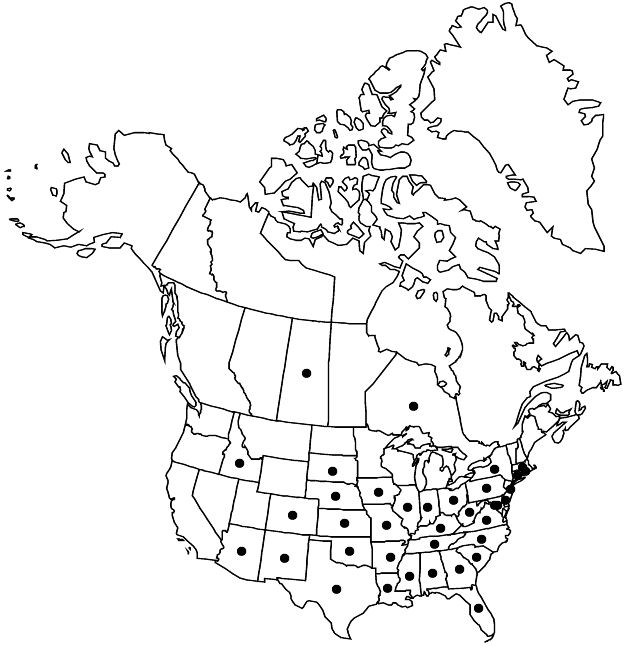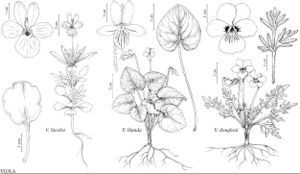Difference between revisions of "Viola bicolor"
Fl. Amer. Sept. 1: 175. 1813.
imported>Volume Importer |
GeoffLevin (talk | contribs) m (Restored part of description lost in parsing.) |
||
| (One intermediate revision by one other user not shown) | |||
| Line 32: | Line 32: | ||
}}<!-- | }}<!-- | ||
| − | --><span class="statement" id="st-undefined" data-properties="">× 0.3–1 cm, base attenuate, margins entire or crenate-serrate especially toward apex, eciliate, apex rounded to obtuse, surfaces glabrous or sparsely pubescent. <b>Peduncles</b> 1–4.5 cm, glabrous or pubescent. <b>Flowers</b>: sepals ovate to lanceolate, margins ciliate or eciliate, auricles 0.5–2 mm; petals white or cream to pale bluish violet on both surfaces, dark purple-veined, lateral 2 longer than sepals, bearded, lowest 8–10 mm, spur white to blue-violet, gibbous, 1–1.5 mm, shorter than or equaling sepal auricles; style head bearded; cleistogamous flowers axillary. <b>Capsules</b> ellipsoid to oblong, 4–7 mm, glabrous. <b>Seeds</b> beige to bronze, 0.3–1.5 mm. <b>2n</b> = 34.</span><!-- | + | --><span class="statement" id="st-undefined" data-properties=""><b>Plants</b> annual, caulescent, not stoloniferous, 3-25 cm. <b>Stems</b> 1-5, prostrate, decumbent, or erect, branched, glabrous or hairy on stem angles only, clustered on taproot. <b>Leaves</b> cauline; stipules palmately lobed, middle lobe not leaflike, oblanceolate to spatulate, margins entire, ciliate or eciliate, apex acute to obtuse; petiole 0.5-2 cm, glabrous or sparsely pubescent; proximal blades ± orbiculate, distal blades spatulate to broadly oblanceolate, 0.5-3 × 0.3–1 cm, base attenuate, margins entire or crenate-serrate especially toward apex, eciliate, apex rounded to obtuse, surfaces glabrous or sparsely pubescent. <b>Peduncles</b> 1–4.5 cm, glabrous or pubescent. <b>Flowers</b>: sepals ovate to lanceolate, margins ciliate or eciliate, auricles 0.5–2 mm; petals white or cream to pale bluish violet on both surfaces, dark purple-veined, lateral 2 longer than sepals, bearded, lowest 8–10 mm, spur white to blue-violet, gibbous, 1–1.5 mm, shorter than or equaling sepal auricles; style head bearded; cleistogamous flowers axillary. <b>Capsules</b> ellipsoid to oblong, 4–7 mm, glabrous. <b>Seeds</b> beige to bronze, 0.3–1.5 mm. <b>2n</b> = 34.</span><!-- |
-->{{Treatment/Body | -->{{Treatment/Body | ||
| Line 62: | Line 62: | ||
|publication year=1813 | |publication year=1813 | ||
|special status=Endemic;Illustrated | |special status=Endemic;Illustrated | ||
| − | |source xml=https:// | + | |source xml=https://bitbucket.org/aafc-mbb/fna-data-curation/src/2e0870ddd59836b60bcf96646a41e87ea5a5943a/coarse_grained_fna_xml/V6/V6_200.xml |
|genus=Viola | |genus=Viola | ||
|species=Viola bicolor | |species=Viola bicolor | ||
Latest revision as of 21:51, 3 January 2025
Plants annual, caulescent, not stoloniferous, 3-25 cm. Stems 1-5, prostrate, decumbent, or erect, branched, glabrous or hairy on stem angles only, clustered on taproot. Leaves cauline; stipules palmately lobed, middle lobe not leaflike, oblanceolate to spatulate, margins entire, ciliate or eciliate, apex acute to obtuse; petiole 0.5-2 cm, glabrous or sparsely pubescent; proximal blades ± orbiculate, distal blades spatulate to broadly oblanceolate, 0.5-3 × 0.3–1 cm, base attenuate, margins entire or crenate-serrate especially toward apex, eciliate, apex rounded to obtuse, surfaces glabrous or sparsely pubescent. Peduncles 1–4.5 cm, glabrous or pubescent. Flowers: sepals ovate to lanceolate, margins ciliate or eciliate, auricles 0.5–2 mm; petals white or cream to pale bluish violet on both surfaces, dark purple-veined, lateral 2 longer than sepals, bearded, lowest 8–10 mm, spur white to blue-violet, gibbous, 1–1.5 mm, shorter than or equaling sepal auricles; style head bearded; cleistogamous flowers axillary. Capsules ellipsoid to oblong, 4–7 mm, glabrous. Seeds beige to bronze, 0.3–1.5 mm. 2n = 34.
Phenology: Flowering Mar–May.
Habitat: Prairies, open woodlands, fields, pastures, roadsides, lawns, waste ground
Elevation: 0–3000 m
Distribution

Ont., Sask., Ala., Ariz., Ark., Colo., Conn., Del., D.C., Fla., Ga., Idaho, Ill., Ind., Iowa, Kans., Ky., La., Md., Mass., Miss., Mo., Nebr., N.J., N.Mex., N.Y., N.C., Ohio, Okla., Pa., R.I., S.C., S.Dak., Tenn., Tex., Va., W.Va.
Discussion
Viola bicolor is the only pansy native to North America (V. B. Baird 1942; J. Clausen et al. 1964; A. E. Radford et al. 1968) and is the only annual Viola species that produces cleistogamous flowers (Baird; A. Gershoy 1934). Roots of V. bicolor have the odor of wintergreen when crushed (W. J. Hayden and J. Clough 1990).
Selected References
None.
